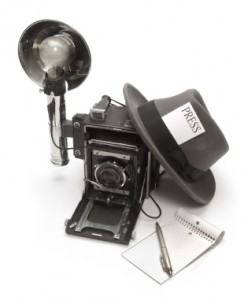 Paul Steiger, Wall Street Journal icon and now editor-in-chief of Pulitzer-winning news site ProPublica, discusses the changing face of journalism.
Paul Steiger, Wall Street Journal icon and now editor-in-chief of Pulitzer-winning news site ProPublica, discusses the changing face of journalism.
Paul Steiger has dedicated much of his life to print journalism. The sixty-eight-year-old journalist worked as managing editor of the Wall Street Journal from 1991 to 2007, a period during which the business-oriented daily was awarded 16 Pulitzer prizes. Today, he’s editor-in-chief of ProPublica, a New York based investigative reporting nonprofit operating on an annual budget of $10 million.
ProPublica produces journalistic content in true American style: comprehensive, meticulous, transparent and with the public’s interest at the forefront. Yet not on paper as tradition would have it, but rather on the Web. More precisely, on www.propublica.org, where investigative reports are published and shared with not only readers, but with other media outlets which may access them for free. ProPublica is, in short, the digital news child of our time. Founded in 2007, it began publishing in 2008 and claimed a Pulitzer by 2010 – the first ever awarded to an online newsroom – for an investigative report on the hospitals of News Orleans after Katrina.
What’s the key to this success? Investing and believing in the potential of the Web, understanding that digital and new technologies better satisfy the readers’ needs, rejuvenating the editorial staff, bringing in new faces (ProPublica has 40 working journalists – the youngest of whom is 23 years old – and approximately 5,000 volunteers and students from various journalism schools), collaborating with traditional media. ProPublica firmly believes in sharing its content and reports with newspapers, radio, television channels and other websites. For example, it collaborates with the CNN, the NBC, the New York Times, the Washington Post, the Huffington Post and many others, ensuring its investigative reports reach the largest possible audience. A sign that the most eminent printed press and traditional media continue to enjoy authoritativeness and credibility, they count on a large and interested readership. A sign also that, in economically difficult times, a non-profit organization like ProPublica can be a valid resource and a paragon on which to draw inspiration for tomorrow’s journalism in terms of high-quality content, human resources and time. In Steiger’s opinion journalism has a future, above all investigative journalism, as do newspapers. In an interview at the Festival of Journalism in Perugia we asked Steiger about journalism’s future in light of his experience at ProPublica and its investigations.
Did you expect to win the Pulitzer Prize?
“To tell you the truth, no, it was a surprise which filled me with great joy. On the other hand, thinking back on the reports we produced last year, at least five were Pulitzer material. I can say that with confidence because I was a member of the Pulitzer governing board for nine years and I know the evaluation criteria and the level of quality demanded. And ProPublica, in collaboration with newspapers such as the New York Times, does this type of reporting. The prize was therefore fully deserved but a real surprise nonetheless.”
How was the idea of ProPublica conceived?
“It was the end-product of a series of events. In 2006, when I was still managing editor of the Wall Street Journal, the Sandlers, that I had known and respected for many years , came to me and told me they wanted to invest $10 million in an investigative journalism project and asked for my advice. I met them again in early 2007 and presented the blueprint of what would become ProPublica. They were excited by the idea.”
So you decided to leave the Wall Street Journal and embark on a digital adventure?
“In 2007 I had already reached retirement age. The thirty-first of December was my last day at the Wall Street Journal, a job I had loved until the very end. In January 2008 ProPublica was launched.”
At the outset, what goals did you hope to achieve?
“Creating an organization that would use journalistic techniques to shed light on abuses of power and injustices in the political, health, public administration and justice sectors.”
Have you been successful so far?
“We have made a lot of progress. Journalistically speaking, we are ahead of schedule by one year. Sure, there is still lots more to do. We want to improve the quality of the journalism in our investigations to broaden our funding base and we want to use our digital techniques and tools to improve both the gathering and distribution of information. I am really satisfied with what we have achieved so far.”
Can you describe ProPublica’s internal organization?
“There is a governing board chaired by Herb Sandler. The board does not interact directly with the journalists and does not know what investigations we are working on. It supports us and advises us on financial and technological aspects. There is an editor-in-chief – that’s me – a general manager, Richard Tofel, who is an attorney by profession and has experience in the field of public relations and non-profit organizations, and a managing editor, Stephen Engelberg, a brilliant journalist and former investigative reporter of the New York Times. Then there are four senior editors working under him with the task of following and offering advice to the 40 or so journalists who work for ProPublica. And, naturally, there are other people who are responsible for the distribution of the content online, the blogs, multimedia applications, social networks and so on.”
What does doing investigative journalism entail?
“It depends on the type of investigation. The story that won the Pulitzer meant many trips to New Orleans, conducting hundreds of interviews, ploughing through hundreds of documents, doing the rounds of all the hospitals to gather information. Other investigations may entail longer trips, even to the other side of the world.”
In other words, it sounds like doing good, traditional investigative journalism using new tools?
“Yes, that’s it exactly. It’s not the quality of the content that changes, just the container.”
ProPublica makes use of volunteers and schools of journalism…
“Yes, we have approximately 5.000 young volunteers who collaborate with us. The schools of journalism in the United States not only teach journalism but also produce publications, both online and printed. And while it has been traditionally difficult for them to do real journalism – even although they had numerous collaborators who produced content – due to the competition of radio, television and newspapers which did not need them, today two significant changes have modified this situation: the number of employees in the traditional media has dropped drastically and the web offers many more opportunities that are within the reach of all. In other words, in my experience the schools of journalism now offer professional skills, experienced professors, know-how and motivated, talented students. So why not involve them?”
But also the traditional media?
“Yes, like the New York Times or CNN. It’s a win-win situation for everyone: it allows ProPublica to reach printed press readers and television viewers who are less familiar with the web or a niche audience and it allows the traditional media to draw on the high quality resources and content we offer on the site free of charge.”
What is the key to the success of journalism and newspapers in the future?
“There is no key, I’m afraid. What I do know is that the advertising rates are much lower on the web than in the printed press and that if the New York Times believed it could survive solely on the revenue from its site, cutting production and distribution costs, it would lose even more money than it does today.”
What’s the answer then?
“One possible answer is without doubt to charge online users more. The New York Times is moving in this direction. On the other hand, while this will create a cash flow it will still not be enough to keep the newspaper afloat. Another answer could be to use qualified bloggers and citizen journalists more.”
In your opinion, in ten years time will there still be journalism and journalists?
“I think there will still be journalism and journalists in 10 years time. It’s just that they will be different. The traditional omnibus formula, the supermarket tabloid, no longer works. In the future this function will be performed online by Google. Newspapers will have to specialize, to niche journalism which proposes exclusive, high quality and original content. They won’t come out every day, they will be increasingly specialized and they will target a niche readership.”
Do you use Twitter and social networks?
“No. I don’t tweet and I don’t have a Facebook account. My wife, who is 25 years younger than me, is a fashion blogger and says to me, “If there is something on Facebook that is worth your while knowing, I’ll tell you.” ProPublica, of course, does use social networks.”
Published in the Corriere del Ticino, May 7th, 2010, by Natascha Fioretti
Tags: Adam Sandler, Digital Technology, Facebook, Investigative Reporting, New media, Nonprofit Journalism, Paul Steiger, ProPublica, Pulitzer Prize, Richard Tofel, Stephen Engelberg, Traditional Media, Twitter, Wall Street Journal















































